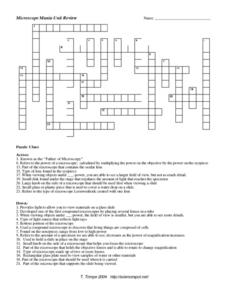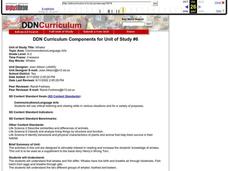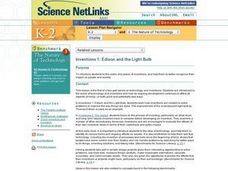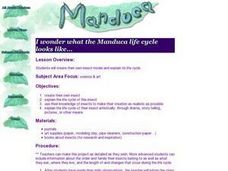Curated OER
Frog and Toad Are Confusing
Third graders are introduced to the similiarties and differences between a frog and a toad. In groups, they compare and contrast them and identify distinguishing characteristics of each. They watch a video on the animals and answer...
Curated OER
Deadly Deserts
In this reading comprehension worksheet, students read a passage regarding different deserts and answer 10 questions. The questions are a mix of true/false, short answer, and matching.
Curated OER
Microscope Mania Unit Review
In this microscope worksheet, students complete a crossword puzzle given twenty three hints about the parts of a microscope, the magnification of a microscope and the types of microscopes.
Curated OER
Bang! You're Alive
Young scholars explore the Big Bang Theory and the Theory of Plate Tectonics. In this history of life lesson, students explain two ways the Theory of Plate Tectonics and the Big Bang are of direct benefits to humans.
Curated OER
Predator vs. Prey
Fifth graders participate in a game to become familiar with predators and preys. In this predator vs. prey lesson, 5th graders ascertain whether a photo shows an organism as a predator or a prey. Students read Killer Creatures. Students...
Curated OER
Whales
Students compare the differences between whales and fish. They examine the differences of toothed and baleen whales. They identify behavioral and physical characteristics of animals that help them survive in their habitat.
Curated OER
Exploring Learned and Innate Behavior
Compare and contrast learned and innate behaviors between humans and primates. Your biology class members read articles and participate in discussions about the use of tools and communication methods. That's about it, you'll probably...
Curated OER
Cells: Nature's Building Blocks
What you will find on this page is the general outline of a unit on the use of a microscope and the structure of the cell. There is no actual educational content here, so you will need to design the details of each of the four student...
Curated OER
Decomposers- Nurse Logs
Pupils investigate temperate forest ecosystems. In this environmental instructional activity, students discover different forms of decomposition and its effect on the environment.
Indian Land Tenure Foundation
Native Foods and Livelihoods
Introduce young scholars to the ways in which land and people have a relationship. They examine the types of food local tribes have traditionally consumed and ways in which the people and the land both benefited from the act of...
Curated OER
The Importance of Plants to Native Cultures in the Past and Present
Eighth graders investigate the founding and history of Sluice Boxes State Park. They use both primary and secondary resources to collect data. The focus is upon the use of native plants to make medicines. They write reports about several...
Curated OER
Inventors and Scientists
Learners research a scientific breakthrough. In this science lesson, students write an essay on a technology that has changed the world.
Curated OER
Raising a Healthy Child
Students identify key features in promoting their child's health. They create their own health and wellness plan for their Students.
Curated OER
Edward Burtynsky's Ship Breaking
Seventh graders view Edward Burtynsky's artwork that represents ship breaking. They view images of recycling, the water cycle, rusted metal, and ships to determine factors that threaten the existence of a particular habitat of an...
Curated OER
Inventions 2: The Impact
Students explore the process of inventing a new product. In this inventions lesson, students explore a timeline that gives a history on significant inventions from ancient times to the present. Students look at pictures of the...
Curated OER
Ecology of The Sonoran Desert Soil Crusts: Biology, Geology
This lesson is designed after research done on the ecology of soil lichen in the Tucson Basin area during the summers of 1997 and 1998. Its purpose is to guide students into adopting the problem solving thinking of ecologists. The lesson...
Curated OER
Minerals of the Earth
Young scholars learn and practice identifying Earth's minerals and their properties. Working in small groups, they evaluate minerals. This is a well-described lesson, which students enjoy.
Curated OER
Inventions 1: Edison And The Light Bulb
Students examine the realm and power of inventions, and recognize their impact on people and society. Small groups pretend to have been hired by Edison to make special posters that advertise the uses and benefits of the light bulb.
Curated OER
INSECTS AROUND US
Students identify characteristics of insects and if insects help or harm us. They describe the stages of metamorphosis.
Curated OER
Plants and Animals
Students find common needs between plants and animals. In this plants and animals lesson students compare that both plants and animals need food and water. They also find the differences between plant and animal needs.
Curated OER
I Wonder What the Manduca Life Cycle Looks Like
Young scholars create their own insect, build a model of it and explain its life cycle.
Curated OER
Predator Or Prey?
Students study the concept of predator/prey by researching specific examples of birds. They participate in a concept map/webbing activity to determine different characteristics of birds. They engage in a class discussion about...
Curated OER
Araceli Solis Butterflies Unit
Third graders study the life cycle, eating habits, habitats, and migration patterns of butterflies in this series of lessons.
Curated OER
Food and the Digestive System
Students investigate the digestive system. In this human biology lesson, students read an article about the digestive system and go onto a suggested website to review what they have learned. Students are asked questions as an assessment.

























